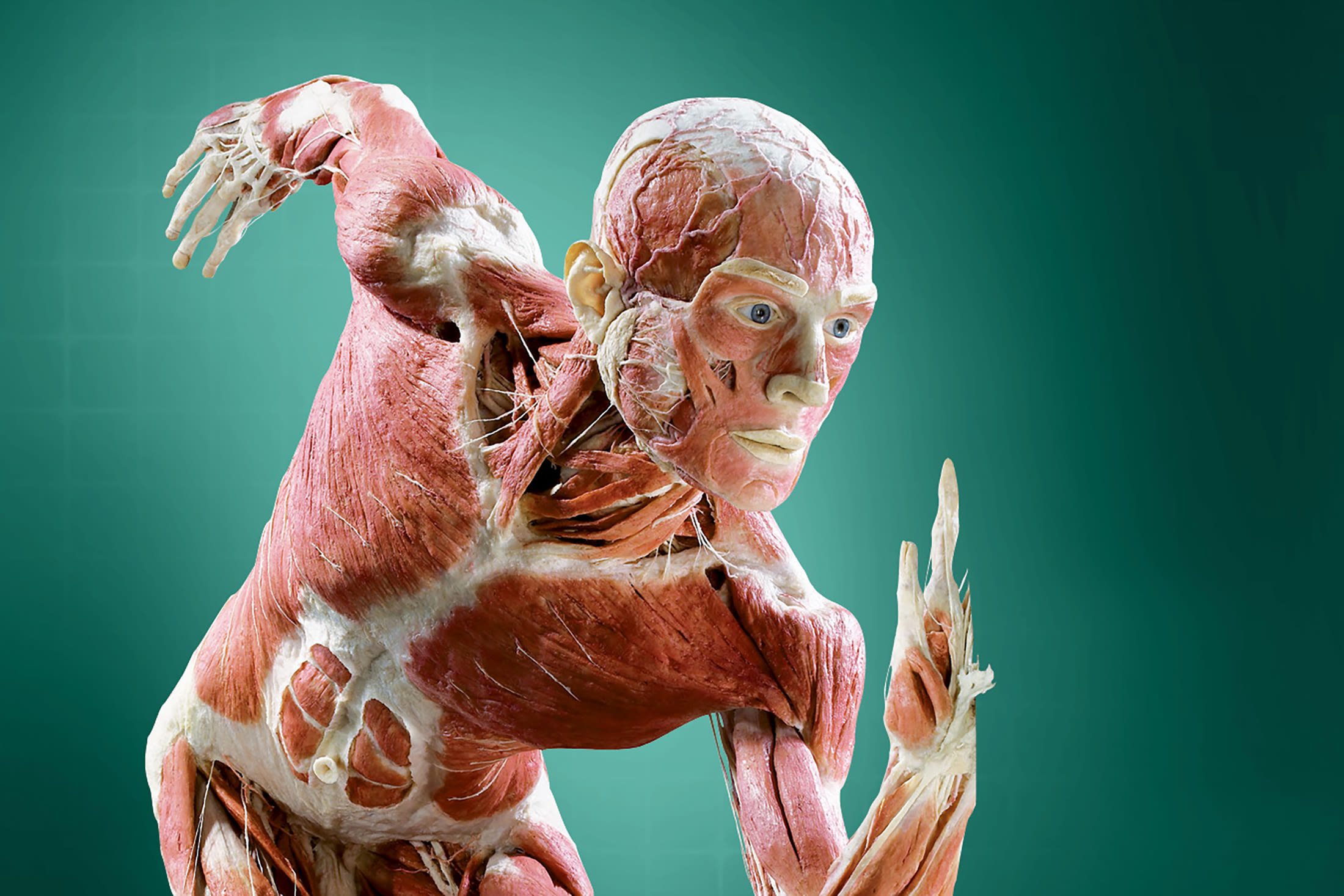What to See and Learn at Holocaust Museum Houston
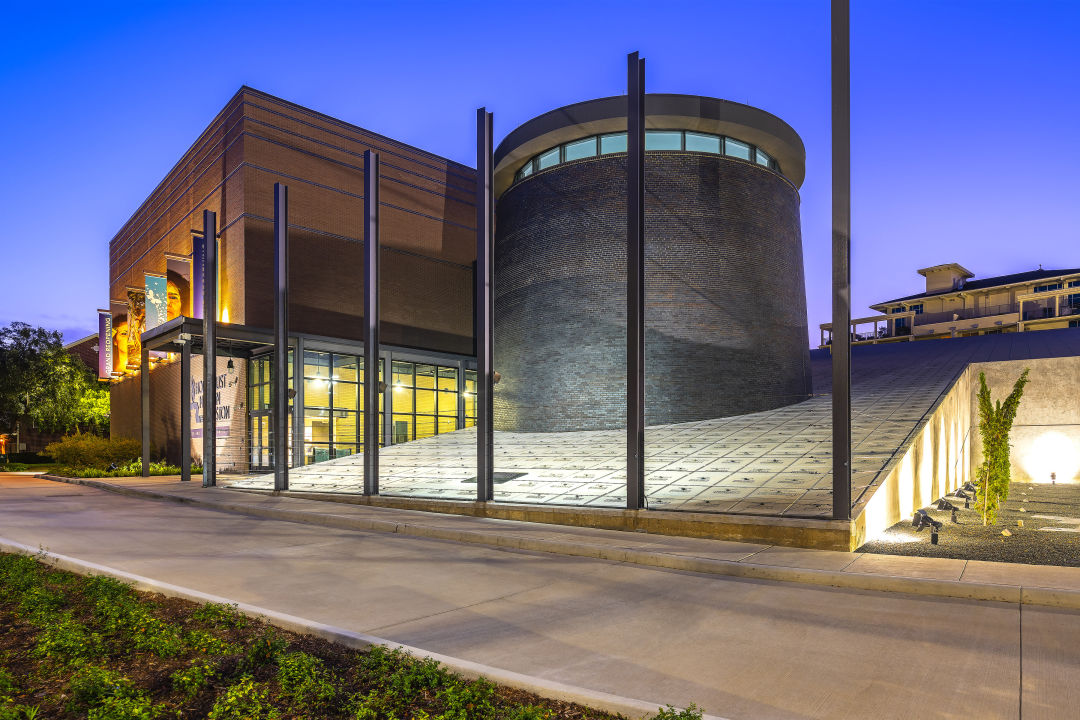
Holocaust Museum Houston is now the fourth-largest Holocaust museum in the country.
Image: G. Lyon Photography Inc.
Originally founded in 1996 by Holocaust survivor and local Houstonian Siegi Izakson, Holocaust Museum Houston (HMH) is now the fourth-largest Holocaust museum in the country. Its goals are to educate visitors about the sobering realities of the Holocaust and memorialize its victims, while also bringing awareness to other international examples of genocide and human rights violations throughout history.
With a recently expanded campus in the heart of the Museum District, today the museum has five permanent exhibitions featuring photographs and artifacts from the Holocaust, including authentic concentration camp uniforms and recovered diary pages written by Jewish teenagers during the war. Each exhibit features interactive technology that allows viewers to see a fully bilingual information display in both English and Spanish.
Just down the street from other Museum District standouts, like Museum of Fine Arts, Houston and Houston Museum of Natural Science, HMH offers an equally compelling visitor experience with a number of special events like film screenings and panel discussions. And, with its permanent and temporary exhibitions of art and history, plus one of the pre-eminent research libraries dedicated to Holocaust and human rights studies in the U.S., there’s a lot to explore at HMH.
Here is a handy visitor’s guide to all that HMH has to offer.
What kinds of exhibits can I see at Holocaust Museum Houston?
HMH offers five permanent exhibitions across its three-story campus, and regularly holds temporary exhibitions focusing on issues like the Holocaust, contemporary human rights, and local history.
The museum’s collection of WWII-era artifacts range from large historic items in the Holocaust Gallery (also called Bearing Witness: A Community Remembers), including a railcar used to transport prisoners to concentration camps that visitors can actually step inside of, and a Danish rescue boat. Visitors can also see small handfuls of soil from some of the most infamous concentration camps, such as Auschwitz, Bergen-Belsen, and Dachau, displayed beneath several memorial walls throughout the museum commemorating the names of individuals killed in the camps.
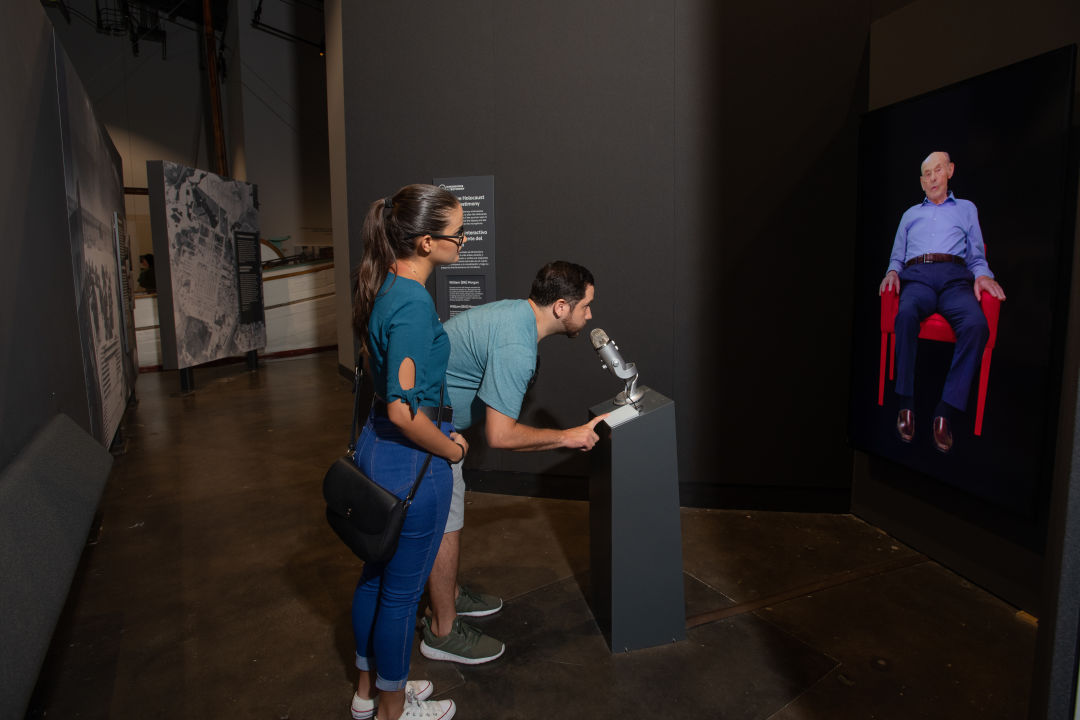
The Dimensions in Testimony exhibit features interviews with Holocaust survivors.
Image: Jeff Fitlow
The Holocaust Gallery also features the innovative holographic technology of Dimensions in Testimony, a project by USC Shoah Foundation, which displays interviews with real-life Holocaust survivors. These pre-recorded interviews are projected onto HD video screens throughout the gallery that visitors can interact with, allowing them to “speak” to the survivors by asking questions about the Holocaust and receiving answers in real-time.
At the Rhona and Bruce Caress Gallery, And Still I Write: Young Diarists on War and Genocide, features pages from the diaries of children and teenagers who lived through World War II, including Jews who lived in Nazi-era Europe, and a Japanese-American teenager whose family was forcibly relocated to Heart Mountain Internment Camp in Wyoming. Touch screens in the gallery offer visitors the ability to interact with the diaries, allowing them to read through entries, view photographs and drawings made by the young writers, and immerse themselves in their stories.
The Texas Liberator: Witness to the Holocaust exhibition shares photographs and stories of 25 American soldiers from Texas who helped liberate concentration camps at the end of the war. The Lester and Sue Smith Human Rights Gallery educates visitors through photos, informational displays, and documentary video projections, on the history of human rights violations and the significant efforts that have been made一and are still being made一toward women’s rights, civil rights, human rights, and equality around the world.
On the first floor, the Memorial Room offers a much needed quiet space to meditate and reflect, and features a Wall of Tears made of 600 hand-painted ceramic tiles representing the six million Jews who died in the Holocaust; as well as a commemorative plaque and soil preserved from Babi Yar, the site of a Nazi massacre in Ukraine.
HMH’s sole permanent gallery dedicated to art is the Samuel Bak Gallery and Learning Center. Located on the second floor, it is filled with surrealistic paintings by Bak, a Polish Holocaust survivor.
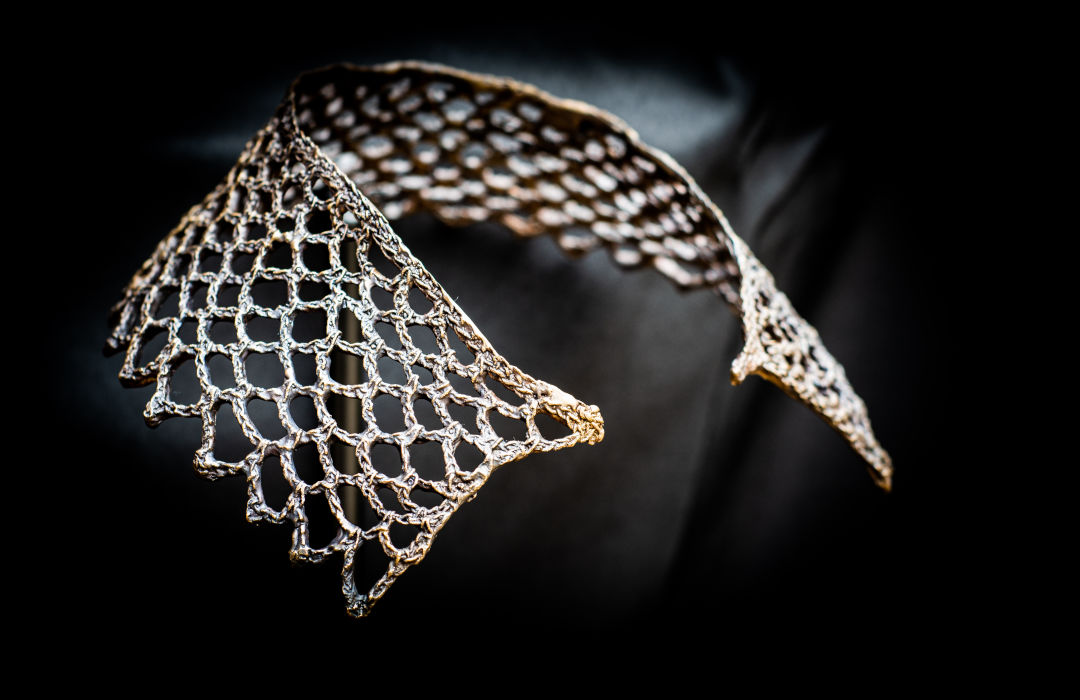
Woman, the Spirit of the Universe, a collection of hand-stitched bronze collars made by local artist Carolyn Marks Johnson, includes a dedication to late Supreme Court Justice, Ruth Bader Ginsburg.
Image: Holocaust Museum Houston
What temporary exhibits are on now or coming soon in 2023?
Upcoming special exhibitions at HMH in 2023 include exhibitions of photography and Jewish culture.
I’ll Have What She’s Having: The Jewish Deli, HMH’s first exhibit centered on food, explores the delicatessen’s pivotal role in building Jewish community and culture in the United States. Menus straight from the personal collection of famed Houston deli man Ziggy Gruber are displayed alongside authentic uniforms, historic posters, and a film compilation of pop culture moments in which the deli stars (including the exhibit’s eponymous When Harry Met Sally scene). I’ll Have What She’s Having runs through August 13.
Jason Langer’s moody photos of Berlin reflect the artist’s evolving view of the city—from the fearful impressions bestowed upon him as a child living on a kibbutz in Israel, to those of an adult seeing the city as a place where darkness and light coexist. Berlin: A Jewish Ode to the Metropolis features 27 photographs from Langer’s series and runs from July 14 to September 10.
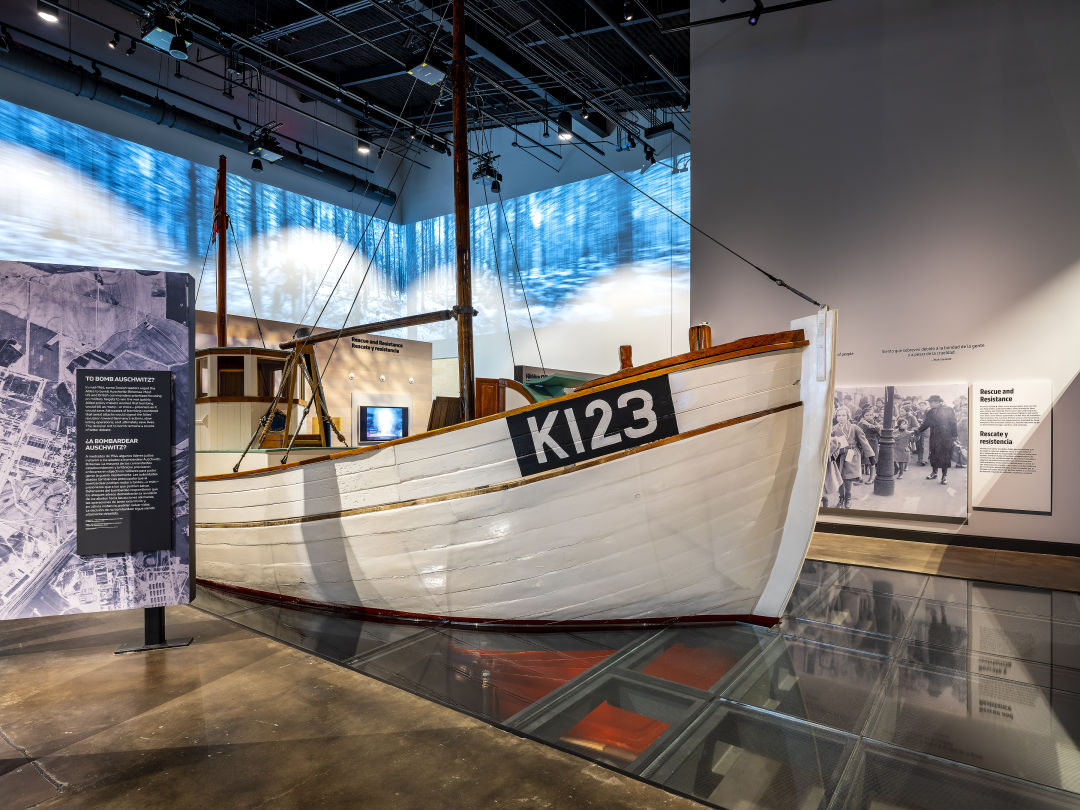
Danish Rescue Boat on display at HMH.
Image: G. Lyon Photography Inc.
What kinds of special events are offered at HMH?
Special events at HMH include opening receptions for temporary exhibitions; lectures, conferences, and curated conversations on history, Jewish studies, and human rights issues; and film screenings and theatrical productions in the museum’s Albert and Ethel Herzstein Theater.
What’s in the Boniuk Library at HMH?
If you’re in need of research materials for a school project, looking to educate yourself more on Holocaust history or human rights issues, or need a new nonfiction recommendation, the Boniuk Library, located on the third floor of the museum, houses over 12,000 books, videos, recordings, and other resources for visitors of all ages to access. The library also offers weekly and monthly events, including author visits, a bimonthly book club, and a kids’ storytime hour every Thursday at 4 p.m.
What is a “fully bilingual” museum?
All wall displays throughout the museum (such as the wall text featured in exhibitions giving historical information regarding the objects on display, as well as directions to different galleries and other amenities in the museum) are written in both English and Spanish, creating an all-inclusive museum experience for visitors who speak either language.
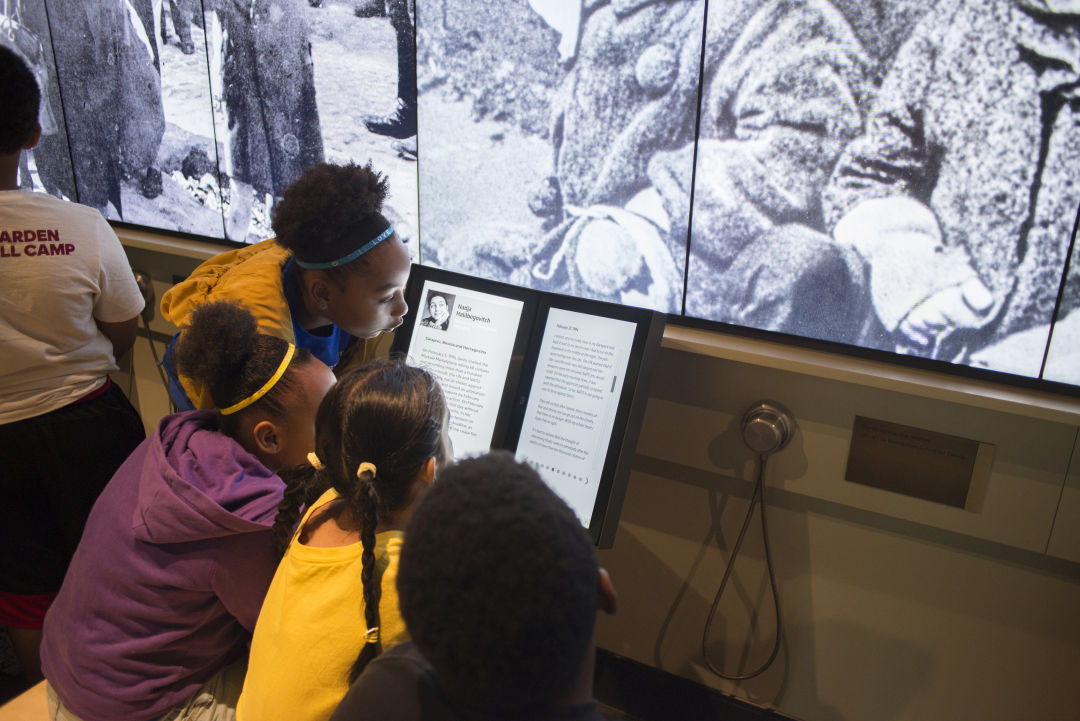
Boys & Girls Clubs of Greater Houston visiting HMH.
Image: Holocaust Museum Houston
How much is admission to Holocaust Museum Houston?
Admission to the museum is $22 for adults, and $16 for seniors age 65 or older and AARP members; active duty military servicemembers and their families get free admission through Labor Day. Infants and kids up to 18 can get in for free, as well as those who have a membership with HMH. Admission to temporary exhibitions and special events is usually also included with general ticket price, so you don’t have to worry about extra fees.
When does Holocaust Museum Houston have free admission?
From 2 p.m. to 8 p.m. every Thursday, the museum offers free admission for all visitors. (And psst: there are plenty of other local museums offering free admission throughout the year, too.)
Can I eat at Holocaust Museum Houston?
The Legacy Cafe, founded by local Jewish caterer Vladimir Smirnov of Chef Smirnov Catering, is located on the second floor. Food options include Caesar and Greek salads, hummus flatbread wraps, sandwiches, and a kids menu featuring quesadillas and pizza bagels. You can also sip on a hot (or cold) drink while you’re there, like an espresso, caramel frappe, hot chocolate, iced tea, or fruit smoothie.
What can I get in the gift shop?
The museum houses a small gift shop on the first floor featuring books, t-shirts, and gifts for all ages, but you can also shop their items online. Browse their collection of Spanish-language books or purchase a Malala pin while you’re there.
Where can I park at Holocaust Museum Houston?
The museum has a parking lot next to the building for visitors to use. Parking is free for up to 30 minutes, then goes to $8 for a visit lasting up to 4 hours. If you’re planning on taking between 4 and 12 hours at the museum, the rate will go up to $12. Members get discounted parking fees.
Where is Holocaust Museum Houston located?
Holocaust Museum Houston’s Lester and Sue Smith Campus is located in the Museum District at 5401 Caroline St.
When is Holocaust Museum Houston open?
The museum is open Tuesday through Wednesday and Friday through Saturday, 10 a.m. to 5 p.m.; Thursday from 10 a.m. to 8 p.m.; and Sunday from noon to 5 p.m. Check their website for holiday hours.
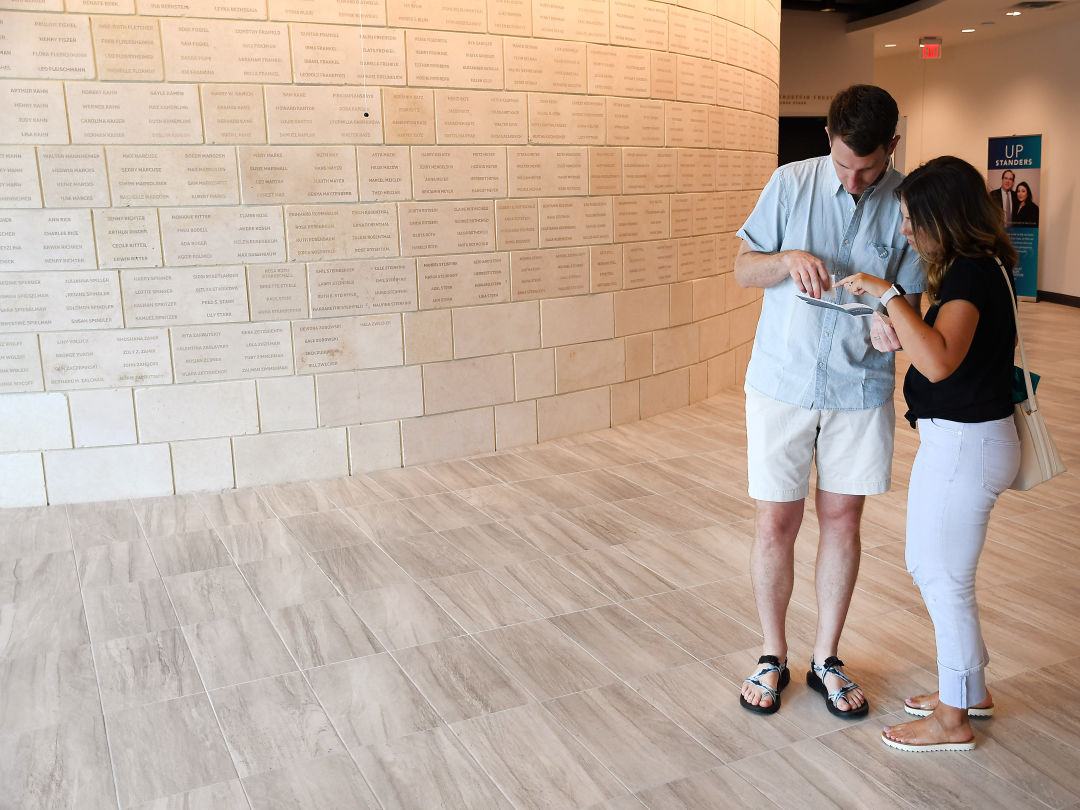
Wall of Tears made of 600 hand-painted ceramic tiles representing the six million Jews who died in the Holocaust.
Image: Holocaust Museum Houston


